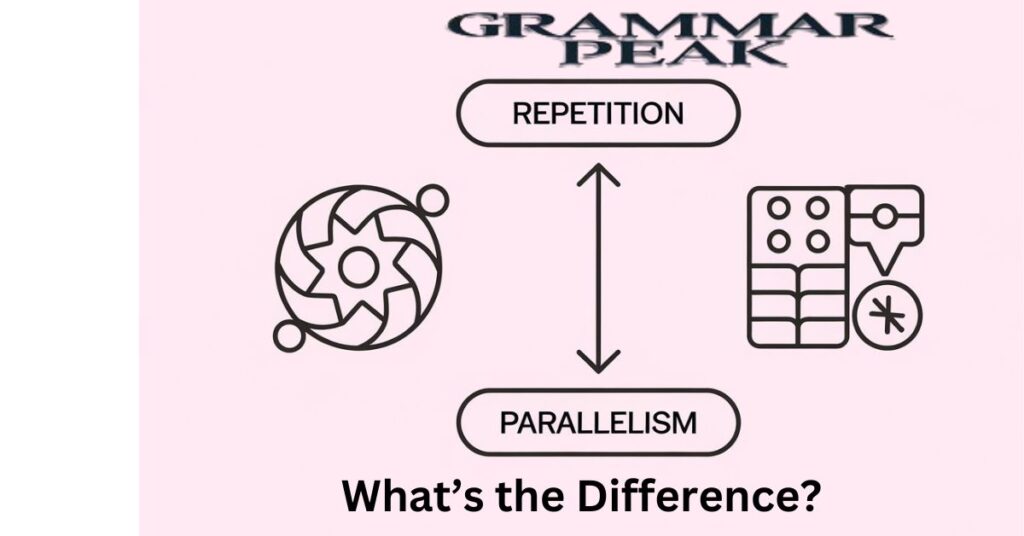Repetition vs Parallelism are two important literary techniques that writers use to enhance their work. Understanding the differences between these two concepts can greatly improve your writing. Both techniques serve unique purposes and can add depth to your sentences.
In this article, we will explore the nuances of repetition and parallelism, providing examples and practical tips. By the end, you will have a clearer understanding of how to use these effective writing tools in your writing.
Repetition
Repetition is a powerful tool in writing. It involves the deliberate reuse of words or phrases to create emphasis. This technique can evoke emotions and reinforce key ideas.
Examples of repetition
Understand repetition, let’s look at some examples. In literature, Shakespeare often used repetition to convey strong emotions.
- The waves crashed against the shore, the waves danced in the moonlight, and the waves whispered secrets to the sand.
- The leaves fell gently, the leaves rustled in the wind, and the leaves covered the ground in a golden blanket.
- The stars twinkled brightly, the stars guided the lost travelers, and the stars filled the night with wonder.
- The clock ticked slowly, the clock counted down the minutes, and the clock reminded us of time’s relentless march.
- The children laughed joyfully, the children played together, and the children created memories that would last a lifetime.
You will like Repetition vs Parallelism: What’s the Difference?
Parallelism
Parallelism is another essential writing technique. It involves using similar grammatical structures in sentences to create balance and clarity. This technique enhances the flow of writing and makes arguments more persuasive.
Examples of Parallelism
- She enjoys hiking in the mountains, swimming in the ocean, and reading by the fireplace.
- The team worked hard to strategize the plan, execute the tasks, and achieve their goals.
- The recipe requires chopping vegetables, boiling pasta, and baking the sauce.
- He wants to travel the world, learn new languages, and experience different cultures.
- The teacher emphasized the importance of studying diligently, practicing regularly, and asking questions.
Origins of Repetition and Parallelism
Both repetition and parallelism have rich histories in literature and rhetoric. These techniques have been used for centuries to enhance communication. Understanding their origins can deepen our appreciation for their effectiveness.
Origins of Repetition
The history of repetition is fascinating. It has been a part of human communication since ancient times. Oral traditions relied heavily on this technique. Storytellers used repetition to engage their audiences and reinforce key themes.
In many cultures, repetition in poetry serves as a way to convey wisdom. For example, in African oral traditions, repeated phrases helped to emphasize moral lessons. This technique made stories more memorable and impactful.
Origins of Parallelism
Parallelism also has a rich history. It emerged in ancient rhetoric as a way to enhance persuasive speech. Greek and Roman orators recognized the power of balanced structures. They used parallelism to create memorable phrases that resonated with their audiences.
In literature, parallelism can be traced back to biblical texts. The Psalms often use this technique to convey spiritual truths. The repetition of similar structures creates a sense of rhythm and harmony.
Repetition vs Parallelism: The Differences
Understanding the differences between repetition and parallelism is crucial for effective writing. While both techniques enhance communication,
| Aspect | Repetition | Parallelism |
| Definition | Repetition involves repeating the same words or phrases for emphasis. | Parallelism uses similar grammatical structures to create balance in a sentence or paragraph. |
| Purpose | Repetition is used to emphasize or accentuate the importance of a word, phrase, or idea. | Parallelism emphasizes uniformity and balance, making statements more persuasive or ideas more memorable. |
| Example | “The sun rose, the sun set, and the sun rose again, marking the passage of another day.” | “I came, I saw, I conquered” – Julius Caesar. |
| Usage | Repetition can be used across all forms of communication to create memorable patterns that resonate with readers. | Parallelism is a rhetorical device that provides emphasis to a central theme or idea the author is trying to convey. |
| Focus | Repetition focuses on echoing the same words or phrases. | Parallelism focuses more on the structure and balance in construction. |
Explore these Repetition vs Parallelism: What’s the Difference?
What is the Difference between Parallelism and Repetition in Poetry?
In poetry, the difference between parallelism and repetition becomes even more pronounced. Repetition in poetry often serves to create rhythm and emotional depth. Poets use repeated words and phrases to evoke feelings and reinforce themes.
Is Parallel Structure Same as Repetition?
Many people wonder if parallel structure is the same as repetition. While they share similarities, they are distinct concepts. Parallel structure refers to the use of similar grammatical forms in a sentence. This technique creates balance and clarity.
In contrast, repetition involves the deliberate reuse of words or phrases. It aims to emphasize specific ideas and evoke emotions. While both techniques can enhance writing, they serve different purposes.
How To Use Repetition and Parallelism In Sentences
Understanding how to use repetition and parallelism in sentences can dramatically enhance your writing. When using repetition, concentrate on the deliberate reuse of words or phrases that you want to emphasize.
Using Repetition
To use repetition effectively, identify the key message or idea you want to emphasize in your writing. Repeat this concept using the same or similar words and phrases.
Remember, repetition is not just about repeating the exact words—it’s about reiterating the main idea in a way that reinforces its significance.
Using Parallelism
When using parallelism, strive for balanced sentence patterns. Your sentences should have a consistent structure that makes your writing fluent and easy to understand. For instance, if you’re listing items, maintain the same grammatical form for each point.
Consider the sentence: “To succeed, we need to plan carefully, execute diligently, and learn continuously.” Here, each verb phrase follows the same pattern, creating a sense of balance and rhythm.
Examples Of Repetition and Parallelism
Repetition
- The rain poured down, the rain soaked the earth, and the rain brought life to the fields.
- The whistle blew, the whistle signaled the start, and the whistle echoed through the stadium.
- The cat purred contentedly, the cat curled up in the sunlight, and the cat dreamed of chasing mice.
- The bell rang loudly, the bell announced the hour, and the bell marked the end of class.
- The fire crackled merrily, the fire warmed the room, and the fire cast dancing shadows on the walls.
- The wind howled eerily, the wind rustled the trees, and the wind carried whispers of the storm.
- The book beckoned invitingly, the book opened to a world of imagination, and the book left an indelible mark on the reader.
- The music played softly, the music filled the room, and the music soothed the weary souls.
- The eagle soared high, the eagle surveyed the land, and the eagle embraced its freedom.
- The snow fell silently, the snow blanketed the ground, and the snow transformed the world into a winter wonderland.
- The crowd cheered loudly, the crowd showed their support, and the crowd celebrated the victory.
- The flowers bloomed brightly, the flowers filled the garden with color, and the flowers whispered of spring’s arrival.
Parallelism
- The artist paints with passion, sculpts with precision, and sketches with spontaneity.
- The scientist observes meticulously, experiments diligently, and concludes logically.
- The chef chops swiftly cooks skillfully, and presents artfully.
- The athlete trains rigorously, competes fiercely, and recovers thoroughly.
- The writer drafts thoughtfully, edits critically, and publishes proudly.
- The student studies consistently, participate actively, and learns eagerly.
- The gardener plants carefully, waters regularly, and prunes timely.
- The musician practices daily, performs confidently, and improvises creatively.
- The teacher instructs clearly, encourages positively, and assesses fairly.
- The photographer frames carefully, adjusts settings appropriately, and captures moments beautifully.
- The architect designs innovatively, plans meticulously, and oversees construction diligently.
- The dancer stretches thoroughly, rehearses tirelessly, and performs gracefully.
Common Mistakes to Avoid
When using repetition and parallelism, it’s essential to avoid common mistakes. Overuse of repetition can lead to monotonous writing. Be sure to vary your word choice and sentence structure to maintain your reader’s interest.
Tips for Using Repetition and Parallelism Effectively
When using these techniques, remember that context matters. (The effectiveness of repetition and parallelism depends on how and when they are used.)
Consider your audience, writing style, and the purpose of your text. (Experiment with these techniques to find what works best for your writing.)
Context Matters
The context in which you use repetition and parallelism significantly impacts their effectiveness. Repetition works well when you want to emphasize a particular point or create a specific rhythm.
Parallelism is effective when you want to present related ideas or points in a clear, balanced manner.
Where not to use Repetition and Parallelism
While both techniques can enhance your writing, they are not always appropriate. Overusing repetition can make your writing redundant and boring. Similarly, forced parallelism can make your sentences awkward and artificial.
Always consider your writing’s purpose and your reader’s perspective when deciding to use these techniques.
FAQ” S
What is Repetition in writing?
Repetition is a literary technique where words or phrases are repeated to emphasize key ideas.
What is Parallelism in writing?
Parallelism is a rhetorical device that uses similar grammatical structures in related phrases or clauses to create balance and clarity.
How does Repetition differ from Parallelism?
Repetition emphasizes specific ideas through repeated words or phrases, while parallelism enhances sentence structure and readability through consistent grammatical patterns.
When should I use Repetition or Parallelism?
Use repetition to emphasize key ideas, and parallelism to present related ideas in a clear, balanced manner.
Can I use Repetition and Parallelism together?
Yes, both techniques can coexist in a piece of writing to enhance emphasis, rhythm, and clarity.
Conclusion
Understanding the difference between repetition and parallelism can significantly enhance your writing. Both techniques serve unique purposes and can add depth to your text, improving its readability and impact. However, it is crucial to use them judiciously and in the right context to avoid monotony and maintain a natural flow. Happy writing!

Mason Blake is an experienced blogger with a passion for language and communication. With years of expertise in crafting informative and engaging content, Mason shares valuable insights on grammar and writing. His clear, concise, and reader-friendly approach has earned him a loyal following, helping readers sharpen their language skills and master the art of effective communication.








Thank you for your sharing. I am worried that I lack creative ideas. It is your article that makes me full of hope. Thank you. But, I have a question, can you help me?
Can you be more specific about the content of your article? After reading it, I still have some doubts. Hope you can help me.
Your article helped me a lot, is there any more related content? Thanks!
Thanks for sharing. I read many of your blog posts, cool, your blog is very good.
Thank you for your sharing. I am worried that I lack creative ideas. It is your article that makes me full of hope. Thank you. But, I have a question, can you help me?
I don’t think the title of your article matches the content lol. Just kidding, mainly because I had some doubts after reading the article.
Your point of view caught my eye and was very interesting. Thanks. I have a question for you.
I don’t think the title of your article matches the content lol. Just kidding, mainly because I had some doubts after reading the article.